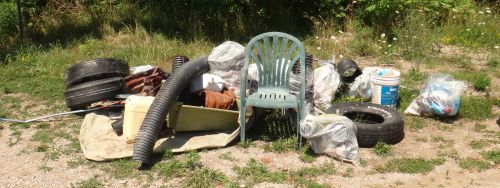Plastic pollution: the solution is you

Plastic pollution is emerging as a serious threat to the Great Lakes. Recent studies by US researchers have discovered that concentrations of plastic in the Great Lakes are higher than those in the Great Pacific Garbage Patch – a sea of floating plastic spanning hundreds of square kilometres discovered in the Pacific in the 1970s.
Plastic littered across the landscape eventually makes its way to the lake through stormwater drains, creeks, streams, and rivers. Once in the lake, plastic floats and can be carried out into the lake, or wash along the shore. Shoreline litter is a mix of what washes in from the lake and what is left behind by beachgoers. The most common plastic litter items found on Lake Huron beaches are cigarette butts and single-use items such as cups, forks, and bottles. It is also quite common to find plastic fragments (pieces of the original item), because plastic only breaks up into smaller and smaller pieces; it never biodegrades.
Large plastic litter items can entangle and harm wildlife, carry aquatic species beyond their normal range, and decrease the aesthetic beauty of the Great Lakes. Small pieces of plastic may be mistakenly ingested by local wildlife causing choking, or if swallowed, malnourishment and/or starvation.
Plastic fragments continue to degrade until they become microplastic pieces. Microplastics can also come from other surprising sources such as personal care products including facial cleansers and body scrubs that contain the ingredients polyethylene and polypropylene, both micro-bead plastics. Synthetic fibres from laundered clothing are also a source because, like personal care products, the synthetic microfibre materials are small enough to wash through sewage treatment plants directly into the lake. Even plastic pellets, industry’s raw plastic material used to create virtually all plastic products, are being found in the lake and on the shore. These pellets are likely coming from spills during transport over land and/or water.
Conclusive impacts from all this plastic in the Great Lakes remain undetermined. The State University of New York is currently looking at ingestion rates of plastic and they are finding plastic in the stomachs of various species of fish and cormorants. Since plastic absorbs persistent organic chemicals such as DDT and PCBs, there is growing concern that plastic may be increasing toxic exposure rates in aquatic food chains, and ultimately in humans. Studies investigating this concern are forthcoming.
The Ontario Government is currently studying the types of plastics found in Lake Ontario with the ultimate goal of identifying specific sources, thus informing new preventative policies. Preliminary results suggest that there are many types and sources of plastic pollution in the lake, including the infamous micro-bead.
While some companies that produce personal care products with micro-beads are volunteering to remove the ingredient by 2017, the Ontario Legislative Assembly has introduced Bill 75, “Micro-bead elimination and monitoring act.†If passed, this bill would ban the manufacture and sale of products containing micro-beads in Ontario within two years of royal ascent, and require the Ontario Ministry of Environment and Climate Change to continue to monitor the Great Lakes for the presence of micro-beads.
Meanwhile, check the ingredients on your personal care products and throw out any that contain micro-beads; do not put them down the drain. Buy products that use recycled plastics, or other alternatives. Always dispose of used plastic responsibly; this includes cigarette butts – yes, cigarette butts are made of plastic.
Beach clean-up events remain a very important last-resort option for keeping plastic out of our Great Lakes. Sign up for a clean-up online at the Great Canadian Shoreline Clean-up website (www.shorelinecleanup.ca), or contact the Coastal Centre to organize a clean-up along Lake Huron’s coast (www.lakehuron.ca).
